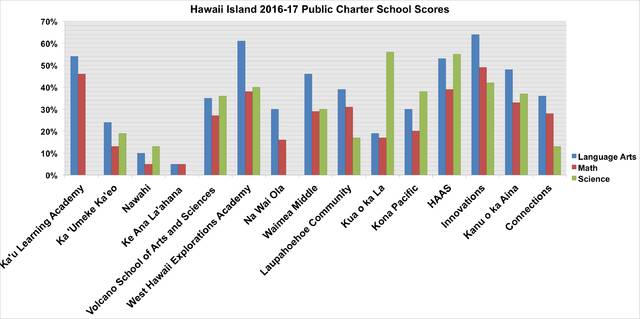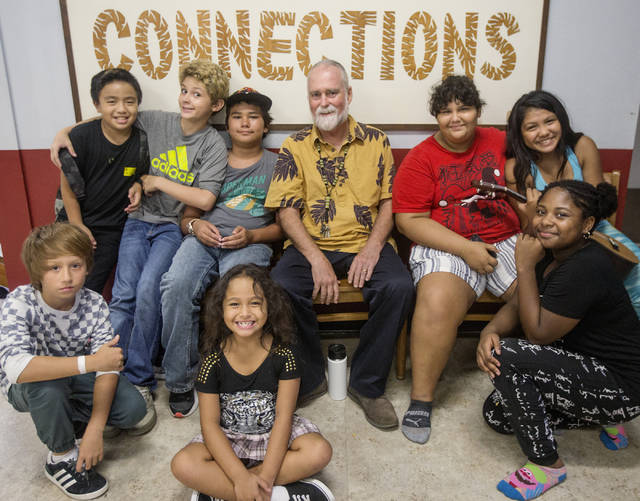HILO — Fewer Hawaii Island charter school students met state testing standards last year, though leaders at some of those schools said results aren’t the best indicator of their students’ progress. ADVERTISING HILO — Fewer Hawaii Island charter school students
HILO — Fewer Hawaii Island charter school students met state testing standards last year, though leaders at some of those schools said results aren’t the best indicator of their students’ progress.
Data released last week from Hawaii’s Strive HI Performance System show about 37 percent of Big Island charter school students who were tested in the 2016-17 school year met or exceeded standards in English language arts, down from about 39 percent in the 2015-16 year. In math, charter students averaged a 26 percent proficiency rate, compared to about 27 percent in 2015-16. Science proficiency was 33 percent, down from about 36 percent in the 2015-16 school year.
Percentages are rounded and calculated as mean averages of the available results for 15 public charter schools on Hawaii Island. There are 36 charter schools statewide, according to the state Department of Education website.
Students at traditional Hawaii Island public schools averaged a 34 percent proficiency rate in math, 40 percent in science and 42 percent in language arts.
Connections New Century Public Charter School Principal John Thatcher said Wednesday he doesn’t believe numbers tell the whole story. He said he’s more concerned with “the growth of the individual student.” The Strive HI system also includes the “median growth percentile” at each school, defined as the relative progress of the average student on state assessments.
Connections’ results showed drops in all tested subject areas. However, Connections students achieved median growth percentiles of 50 in language arts and 59 in math. That means the average Connections student performance in math was better than 59 percent of students that scored similarly on previous state tests.
Charter schools with a high number of special needs, English-learner and low-income students face more challenges, Thatcher said, and some students enroll in charter schools who are unsuccessful in traditional schools and thus may “start at different levels.”
“To me, it’s most important the individual child is making progress,” said Thatcher, whose school is in Hilo. “We’re not going to stress out over what our test scores are. We’re going to stress out about each individual kid making progress and doing the best they can. If I can see an individual kid making progress, that’s a good indicator.”
Hawaii Island immersion schools — where many students are instructed entirely in Hawaiian — say they also face challenges with state tests because they’re administered in a language different from that in which students are instructed.
Hilo immersion school Ka ‘Umeke Ka‘eo conducts its own testing year-round of its students’ achievement, principal Olani Lilly told the Tribune-Herald.
And at Ke Kula ‘o Nawahiokalani’opu’u or “Nawahi” immersion school in Keaau, many parents opt their children out of the state assessments as a form of boycott, and thus the number of students actually tested is very low, board member William Wilson said.
While the state is working to address the issue — it’s currently reviewing and developing Hawaiian language assessments — Wilson said state tests currently offered “weren’t designed for Hawaiian immaersion schools.”
Strive HI was launched in the 2012-13 school year as the state’s locally designed performance system. It tracks school performance and progress and includes test scores, graduation rates, college enrollment, reading levels and chronic absenteeism, defined as the number of students who miss at least 15 days of school in a year.
Language arts and math scores are based off the Smarter Balanced Assessment. Science scores are from the Hawaii State Assessment in Science.
Islandwide, charter students averaged about a 22 percent chronic absenteeism rate.
Connections featured the highest chronic absenteeism rate last year at 46 percent.
Ka’u Learning Academy reported 4 percent, the lowest islandwide.
Thatcher said some charter schools are “a little bit handicapped,” because unlike traditional public schools, “we’re not serving a geographic population.”
“So you’re drawing in kids coming from greater distances, and all kinds of things can happen when you come from so far,” he said. “It’s good to be aware of it but there’s only so much we can do.”
To view results for individual schools visit: https://tinyurl.com/StriveHIcharter




